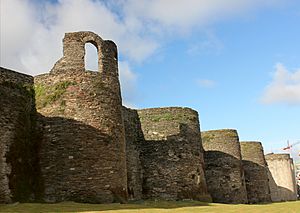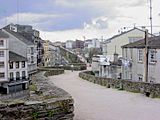Roman walls of Lugo facts for kids
|
Muralla Romana de Lugo
|
|
 |
|
| Location | Lugo, Spain |
|---|---|
| Coordinates | 43°00′40″N 7°33′12″W / 43.0111°N 7.5533°W |
| Type | Roman defensive walls |
| Type: | Cultural |
| Criteria: | iv |
| Designated: | 2000 (24th session) |
| Reference #: | 987 |
| Region: | Europe and North America |
| Area: | 1.68 ha (4.2 acres) |
| Buffer zone: | 59.88 ha (148.0 acres) |
| Type: | Non-movable |
| Criteria: | Monument |
| Designated: | 16 April 1921 |
| Reference #: | RI-51-0000191 |
The Roman walls of Lugo are amazing ancient walls in Lugo, Spain. They stretch for about 2,120 meters (that's over 1.3 miles!) around the city's old town. These walls were built by the Romans way back in the 200s AD. Their main job was to protect the old Roman town, which was called Lucus Augusti back then.
These walls are still mostly standing today. Because they are so well-preserved, they were named a UNESCO World Heritage Site in the year 2000. They are now a very popular place for tourists to visit.
Contents
What the Walls Look Like
How the Walls Were Built
The city walls were built between the years 263 and 276 AD. They were made to protect the Roman town of Lucus Augusti (which is now Lugo). The walls helped defend the town from local tribes and invaders from Germany.
These walls were part of a bigger defense system. This system also included a moat (a deep ditch) and an open space called an intervallum. This space was kept clear between the walls and the city. The walls are about 2,120 meters long. They surround an area of about 34.4 hectares. Not all of the town was inside the walls. Some parts in the southeast were left unprotected. Other areas that were not used were still included inside the walls.
The walls are about 4.2 meters (13.8 feet) wide. Their height changes, from about 8 meters (26 feet) to 12 meters (39 feet) tall. The walls have an inner and outer layer of stone. The middle part is filled with earth mixed with gravel, pebbles, and old Roman stones. These stones were recycled from buildings that had been taken down. Everything was held together with cement and water.
Gates for Entering the City
There are ten gates in the walls. Five of these gates are from Roman times. The other five were added after 1853. These new gates were built because the town was growing and needed more ways to get in and out.
The best-preserved original gates are the Porta Falsa and the Porta Miña. The Porta Miña still has its original arched entrance. This arch is set between two towers. There are five stairways and one ramp that let people get up onto the top of the walls. Once on top, you can walk along the parapet (the protective wall). Inside the main walls, some double staircases help people reach the towers from the parapet walk.
Towers Along the Walls
Many of the original towers are still standing. Forty-nine towers are completely intact. Another 39 towers have partly survived. These towers were built at different distances from each other along the walls.
Most of the towers have two levels and are shaped like a half-circle. A few of them are rectangular. The space between the towers can be from 5.4 meters (17.7 feet) to 12.8 meters (42 feet). Different materials were used to build the towers. Often, the bottom part of a tower was made of cut granite. The rest of the tower was built using slate.
History of the Walls
A Path for Pilgrims
During the Middle Ages, many pilgrims walked through the gates of the Lugo walls. The Porta Miña gate was especially used by pilgrims. They were on their way to Santiago de Compostela as part of the Way of St. James.
The Walls Today
The Lugo walls were added to UNESCO's World Heritage List in late 2000. They were called "the finest example of late Roman fortifications in western Europe." This means they are one of the best Roman forts left in Europe. The walls have also been a Spanish monument since 1921.
In 2007, the Lugo walls were "twinned" with the Great Wall of China. This was done in a special ceremony. China's ambassador to Spain, Qiu Xiaoqi, was there.
Today, there is a walkway on top of the walls. Visitors can walk along the entire length of the walls. Lugo also has a visitor's center about the walls. It is called the Centro de Interpretación da Muralla. Since the walls became a World Heritage Site in 2000, Lugo holds a popular festival each year. It is called Arde Lucus. This festival celebrates the city's Roman past.
Gallery
See also
 In Spanish: Muralla romana de Lugo para niños
In Spanish: Muralla romana de Lugo para niños
- Roman bridge of Lugo
- List of Roman sites in Spain
- London Wall
- Aurelian Walls
- Servian Wall





